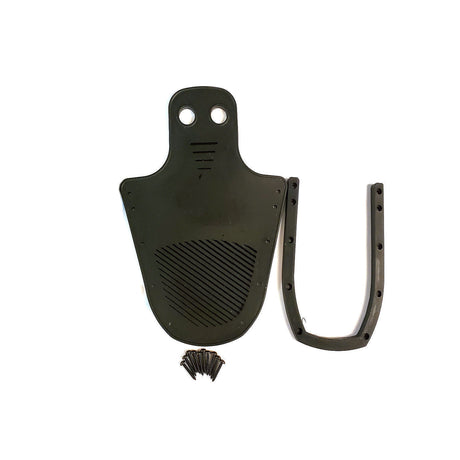Wakeboarding is arguably the most exciting towed watersport. It combines the speed and technical ability of water skiing with the carving and trick work of surfing. But getting into the sport can seem daunting. Let's make it easy.
Here we're covering essential wakeboarding gear, how to pick the perfect beginner board, how to get up on the wakeboard, and how to turn, and we'll provide some additional tips to ensure your success on the water.
Wakeboarding Gear

Pictured: Liquid Force Trip Wakeboard w/ Index Bindings
You'll obviously need some gear before you start carving the wake. Here's a breakdown of the essential wakeboarding equipment you'll need:
1. Life Jacket or Comp Vest

Pictured: Hyperlite Men's Indy Life Jacket
Safety should always be your top priority when wakeboarding. A Coast Guard-approved life jacket or competition vest is mandatory. These vests are designed to provide buoyancy and protect you in case of falls. Make sure it fits snugly and comfortably.
Make sure you get the right life jacket to maximize comfort, maneuverability, and protection. Read our Guide to Life Jackets.
Some states require specific flotation devices be worn when wakeboarding. Read the Guide to Life Jacket Laws by State.
2. Wakeboard

Pictured: Ronix Vault Wakeboard
Your choice of wakeboard is crucial to your learning experience. For beginners, consider the following features:
- Size: Opt for a longer, wider board for stability and easier control.
- Rocker: A continuous rocker helps with stability and promotes a smooth ride.
- Fins: Larger fins provide better control for beginners.
There are many more aspects of a wakeboard to consider. Read our in-depth Guide to Wakeboard Profiles, Sizes, and Shapes.
3. Bindings

Pictured: O'Brien Clutch Wakeboard Bindings
The bindings are the boots that secure your feet to the wakeboard. There are plenty of different types of bindings, including open-toed boots, closed-toe boots, and rear toe plates.
We've got plenty of guides that cover bindings in depth below, but the simple summary is this: Closed-toe boots provide the most support and protection, while open-toe boots provide better ventilation and freedom of movement with your toes. Toe plates are super convenient, since they're easy to slip in and out of.
- Read: Open-Toe vs Closed-Toe Bindings: Which is Better?
- Read: Types of Wakeboard Boots & Bindings Compared
To make finding your first setup easier, we recommend a packaged wakeboard. These packages include a ready-to-ride board with bindings (boots and the mounting hardware) preinstalled and ready to wear.
3. Wakeboard Tow Rope

Pictured: Proline Launch Package Wake Rope & Handle (65')
You'll need a non-stretch, wakeboard-specific rope and handle. These ropes offer consistent tension and control, essential for wakeboarding maneuvers.
How to Get Up and Move on a Wakeboard

Getting up on a wakeboard can be challenging for beginners, but with practice, it becomes second nature. Here's a step-by-step guide:
Step 1: Preparing to Start
- Begin in the water with your knees bent.
- Extend your arms in front of you, grasping the handle.
- Keep your board perpendicular to the towboat.
It helps to imagine yourself sitting in an invisible chair, leaning back slightly, to obtain the optimal starting position in the water.
Step 2: Signal the Boat
- Raise your hand to signal the boat driver to start the pull.
Step 3: Gradual Pull
- As the boat starts to move, let it pull you gently.
- Maintain your body position with knees bent and arms extended.
- As you gain speed, your wakeboard will begin to generate lift.
- This will give you a stable platform upon which to stand.
Step 4: Stand Up
- To get standing and riding, first straighten your legs while keeping your arms extended.
- As you rise out of the water, begin rotating your body and board so both are parallel with the direction of the boat.
Step 5: Balanced Stance
- Once you're up, center your weight over the board.
- Keep your knees slightly bent and your arms relaxed but extended.
- You're officially wakeboarding!
Tip: Once you're up and moving, keep your eyes toward the horizon. New riders tend to look down at their board and bindings, which throws off their balance.
How to Turn on a Wakeboard

Pictured: Hyperlite Women's Eden 2.0 Wakeboard
Now that you're up and moving on the wakeboard, it's time to learn how to turn:
Heel-side and Toe-side Turns
- To initiate a heel-side turn (turning on your heels), shift your weight to your heels and gently lean back.
- To initiate a toe-side turn (turning on your toes), shift your weight to your toes and gently lean forward.
- Use the edges of the board to carve through the water.
Tip: Many new wakeboarders like to learn how to ride at slow tow speeds. But more speed means better stability in turns. Don't be afraid to increase the tow speed slightly when you're practicing turning.
Carving
- As you become more comfortable, experiment with carving. This involves using your board's edges to make controlled turns.
- Edge your board to the left to go left, and edge it to the right to go right.
- Practice carving gradually, and avoid making abrupt turns until you're confident.
Ready to go "full-send"!? Read How to Jump the Wake With a Wakeboard.
More Tips for Wakeboarding Success
As you progress in your wakeboarding journey, consider these additional tips:
Practice Your Balance
Learn to Ride on The Edge
Work on Your Strength
Take Lessons
Safety First
Always wear your life jacket or comp vest. Communicate clearly with the boat driver using hand signals. Be aware of your surroundings and other boater, and ride at safe tow speeds.
Read to Get Your Kids Wakeboarding?
Read our guide on How to Pick The Perfect Kid's Wakeboard!












